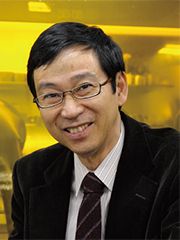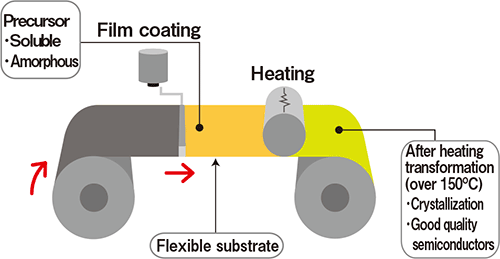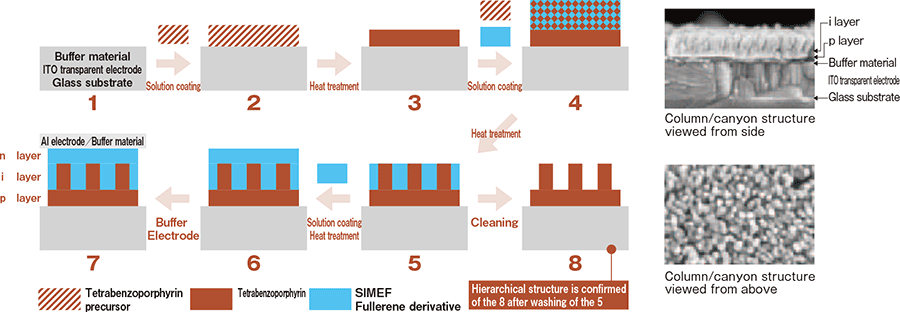Research Results
Definitive solar energy!
Everything made solar cells just be applying!FY2016

- Eiichi Nakamura (Professor, The University of Tokyo)
- ERATO
- "Nakamura Functional Carbon Cluster Project" Research General Overview (2004-2009)
- S-Innovation
- Developing new electronics technologies based on organic materials
"Creating long-life organic solar cell coatings and developing basic technologies aimed at practical applications" Project manager (2009-)
Technology like magic: all kinds of things functioning as solar cells
Quite some time has passed since the widespread call for conservation of electricity in the wake of the Great East Japan Earthquake, but during this time, the level of interest in natural energy has increased markedly. Natural energy includes non-exhaustible forms of energy such as solar power, hydropower, geothermal power, and wind power; of these, solar power is certainly the form of natural energy that most closely surrounds us. It's reasonable to suggest that solar power is the only form of natural energy that regular individuals are able to get their hands on. However, despite lowered costs, introducing this technology to residential houses remains difficult at the moment without national or municipal assistance.
Research on technology that may overturn our basic notions of solar power generation is currently being conducted by Professor Eiichi Nakamura, who also opened up fundamental research into fullerene compounds. Through an industry/academic liaison project with Mitsubishi Chemical Corporation, Professor Nakamura's work is moving one step closer to practical implementation. The technology known as'organic thin-film solar cells,' once mass production commences, will be able to provide significantly more control over production costs compared to current cheap silicon solar cells. This alone would be an outstanding achievement, but its most remarkable attribute is the fact that with a simple thin film coating, the material itself can generate electricity from sunlight. This means that what was previously a dream has become possible; for example, roofing tiles coated with this process would remain unchanged in appearance, but would provide the household's entire energy needs. In the near future, all sorts of unexpected objects — not only engineered products such as automobile bodies, but also things like curtains, walls, and so on — might be used to generate electricity.
Manufacturing enabled with printing technology
Organic thin film solar cells are manufactured from a combination of two types of organic semiconductor: an electron donor material which donates electrons and an electron acceptor material which accepts electrons. If the coating technology continues to improve, these two organic semiconductors will be able to be manufactured in a process just like printing. Since soft materials can also be coated, they can be bent and curved, and colors can be added. If this technology can be properly implemented, it has the potential to change the world dramatically through green energy.
Diagram of continuous coating film application process

Successfully breaking all kinds of boundaries
The development of organic thin film solar cells was a laborious search for the ideal combination of electron donor material and electron acceptor material. After a great deal of repetitive trial-and- error experimentation, a new concept for combining these two elements was discovered. This was a combination of tetrabenzoporphyrin and the independently developed fullerene compound SIMEF. Tetrabenzoporphyrin was not originally developed for solar cell research, but rather for completely different applications. Combining tetrabenzoporphyrin with SIMEF gave clear indications of an ideal structural configuration known as the'column/ canyon 'structure. With that, Japan's own unique printable low-molecular organic thin film solar cells were born. This combination increased conversion efficiency from just over 2% to 5.4%: a dramatic developmental leap.
Collaborative research by materials physicists and chemists has almost never been undertaken in the field of solar cell research, until now. The ERATO project enables research to take place beyond organizational boundaries; the invention of organic thin film solar cells was born of precisely such a process of concept sharing between materials physicists and chemists. This research has also been designated S-Innovation and has been gathering increased attention as a model case of collaborative development between industry and academia. This outcome has been truly been achieved by breaking all kinds of boundaries.
Solution-processable three-layered p-i-n organic photovoltaic devices deposition process

Collaboration with Mitsubishi Chemical Corporation aims at practical applications
Organic thin film solar cells are indeed an amazing discovery, but there are still problems to be solved before these can see practical implementation. The first is energy conversion efficiency. Compared to conventional silicon solar cells, the conversion efficiency of organic thin film solar cells is quite low. In 2009, Professor Nakamura increased this to 5.4% — the world's highest level at the time — but this figure was still rather low in comparison with the conversion efficiency of silicon solar cells. However, since they can be produced extremely efficiently compared to silicon solar cells — the "roll to roll" coating process enables continuous production — together with their module efficiency of about 7%, equivalent for amorphous silicon solar battery (10% cell efficiency), they were believed to have significant potential for market penetration. Subsequently, in September 2012, Professor Nakamura's development partner Mitsubishi Chemical Corporation announced that it had lifted the conversion efficiency of organic thin film solar cells to 11.7%. With this announcement, the problem of conversion efficiency will move steadily towards resolution, making this a major step forward for practical implementation.
Durability is a further problem. Until now, organic thin film solar cells have been easy to manufacture but have had concomitant problems with durability. However, as at 2011, they have been proven to possess more than 5 years of durability using plastic substrate and 10 years using glass. The technology has overcome a significant barrier, and the future world of our dreams beckons. The industry/academic collaborative projects that JST promotes are demonstrating some outstanding outcomes.
